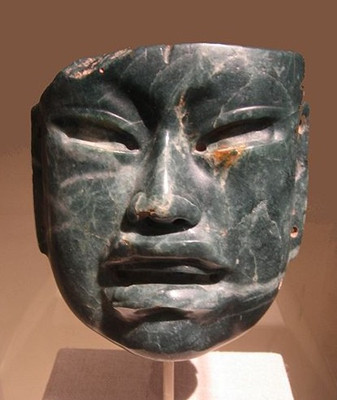We're used now to face-piercings and studs, but this man must have been wearing plugs.
我們如今對在臉上穿孔與飾釘已習以為常,但他的孔更大,想必是戴著塞子。
We know that piercings and plugs are common throughout the history of Central America.
穿孔與戴塞在中美洲的歷史上都極為常見。
Alterations like these, in the name of Olmec beauty, would have transformed the face-and today it's only in masks like this that we can have any idea of what the Olmecs would have looked like, for the skeletons have completely dissolved in the acid soil of the rainforest.
這種奧爾梅克式的美會改變面部外形。只有這樣的面具才能讓們了解奧爾梅克人曾經的長相,因為他們的尸骸都已被雨林的酸性土壤消解干凈。
But the Olmec sense of personal beautification could go far beyond cosmetics or jewellery.
但奧爾梅克人的審美還超越了化妝品與珠寶,進入了神話與信仰的領域。
Here's Karl Taube again:
卡爾陶布形容:
"They would modify their heads-it's often called cranial deformation, but I think that's a loaded word.
他們會改變自己的頭部形狀,人們通常稱之為顱骨變形。但我覺得這種說法有點言過其實。
For them it was a mark of beauty.
對他們而言這是一種美的標記。
For newborns, they would bind their heads, and so they would become elongated-some people call it avocado head.
他把新生兒的頭綁起來,使其變得修長,有人稱之為鱷梨頭。
But really what they're evoking is their head as an ear of corn.
但他實際上希望自己的頭像一個玉米。
And so the Olmec really were truly the people of maize."
奧爾梅克人是和玉米密不可分的民族。
Sadly there are only a few Olmec inscriptions-or glyphs-now surviving, and decipherment of their writing is tentative at best.
遺憾的是,留存下來的奧爾梅克文字數量不多,而我們的解讀如今還只停留在初級階段。
There just isn't enough continuous writing to let us be certain of what the symbols mean.
沒有足夠多的連續文字,便無法確定這些符號的意義,因此只能去推測他們對神靈或自然循環的看法。
But there are lots of objects bearing symbols, marks and glyphs, such as pottery and sculptures, and they show us that writing was originally widespread across the Olmec heartland.
但很多物品,如陶罐、雕像上都有符號、標記或象形文字,表明文字在奧爾梅克中心地區已被廣泛使用。












